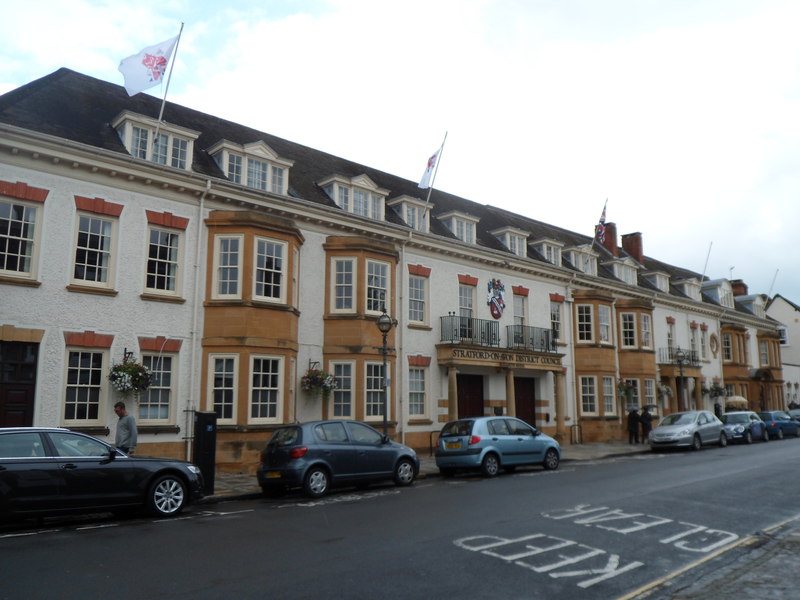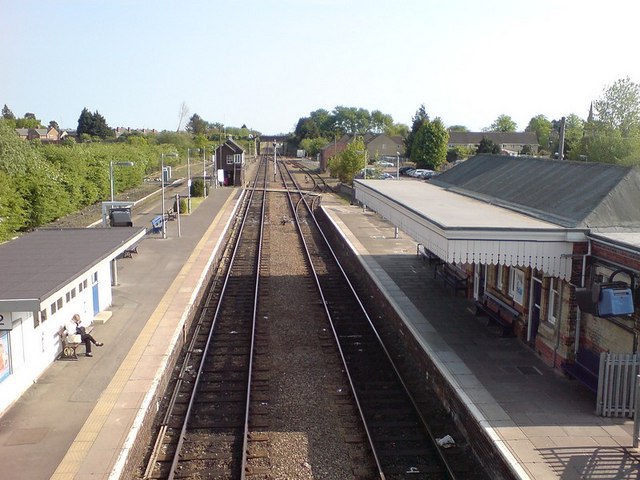|
Stretton-on-Fosse Railway Station
Stretton-on-Fosse railway station was a railway station which served the village of Stretton-on-Fosse, Warwickshire, England. It was located north-east of the village near the Fosse Way road. History In 1836 a tram with horse-drawn cars began passing through the village, operated by the Stratford and Moreton Tramway on a four-feet gauge rail. After the company's insolvency in 1868 the line was purchased by The Great Western Railway. The tramway was converted into a steam operated branch line by the Great Western railway in 1889, between Moreton-in-Marsh and Shipston-on-Stour which was used for passengers until 1929 and goods until 1960. A railway station was not built at Stretton-on-Fosse until October 1892, in the north-east part of the village near the Fosse Way The Fosse Way was a Roman road built in Britain during the first and second centuries AD that linked Isca Dumnoniorum (Exeter) in the southwest and Lindum Colonia (Lincoln) to the northeast, via Lindinis (Ilc ... [...More Info...] [...Related Items...] OR: [Wikipedia] [Google] [Baidu] |
Stratford-on-Avon District
Stratford-on-Avon is a local government district in southern Warwickshire, England. The district is named "Stratford-on-Avon" unlike its main town of Stratford-upon-Avon where the district council is based. The district is mostly rural and covers most of the southern half of Warwickshire. As well as Stratford, other significant places in the district includes the towns of Alcester, Southam, Shipston-on-Stour and Henley-in-Arden, and the large villages of Bidford-on-Avon, Studley and Wellesbourne, plus numerous other smaller villages and hamlets. It borders the Warwickshire districts of Warwick to the north, and Rugby to the north-east. It also borders the neighbouring counties of the West Midlands, Worcestershire, Gloucestershire, Oxfordshire, and Northamptonshire. History The district was formed on 1 April 1974 under the Local Government Act 1972 by the merger of the municipal borough of Stratford-upon-Avon, Alcester Rural District, Shipston-on-Stour Rural District, S ... [...More Info...] [...Related Items...] OR: [Wikipedia] [Google] [Baidu] |
Moreton-in-Marsh Railway Station
, symbol_location = gb , symbol = rail , image = Moreton-in-Marsh Railway Station.jpg , borough = Moreton-in-Marsh, Cotswold , country = England , coordinates = , grid_name = Grid reference , grid_position = , manager = Great Western Railway , platforms = 2 , code = MIM , classification = DfT category E , original = Oxford, Worcester and Wolverhampton Railway , pregroup = Great Western Railway , postgroup = GWR , years = , events = Station opened , mpassengers = , footnotes = Passenger statistics from the Office of Rail and Road Moreton-in-Marsh railway station is a railway station serving the town of Moreton-in-Marsh in Gloucestershire, England. It is on the Cotswold Line between and stations. The station and all passenger trains serving it are operated by Great Western Railway. History The station was opened by the Oxford, Worcester and Wolverhampton Railway (OWW) on 4 June 1853, the day that the southern section of the OWW's main line, that ... [...More Info...] [...Related Items...] OR: [Wikipedia] [Google] [Baidu] |
Railway Stations In Great Britain Opened In 1919
Rail transport (also known as train transport) is a means of transport that transfers passengers and goods on wheeled vehicles running on rails, which are incorporated in Track (rail transport), tracks. In contrast to road transport, where the vehicles run on a prepared flat surface, rail vehicles (rolling stock) are directionally guided by the tracks on which they run. Tracks usually consist of steel rails, installed on Railroad tie, sleepers (ties) set in track ballast, ballast, on which the rolling stock, usually fitted with metal wheels, moves. Other variations are also possible, such as "slab track", in which the rails are fastened to a concrete foundation resting on a prepared subsurface. Rolling stock in a rail transport system generally encounters lower friction, frictional resistance than rubber-tyred road vehicles, so passenger and freight cars (carriages and wagons) can be coupled into longer trains. The rail transport operations, operation is carried out by a ... [...More Info...] [...Related Items...] OR: [Wikipedia] [Google] [Baidu] |
Railway Stations In Great Britain Closed In 1917
Rail transport (also known as train transport) is a means of transport that transfers passengers and goods on wheeled vehicles running on rails, which are incorporated in tracks. In contrast to road transport, where the vehicles run on a prepared flat surface, rail vehicles (rolling stock) are directionally guided by the tracks on which they run. Tracks usually consist of steel rails, installed on sleepers (ties) set in ballast, on which the rolling stock, usually fitted with metal wheels, moves. Other variations are also possible, such as "slab track", in which the rails are fastened to a concrete foundation resting on a prepared subsurface. Rolling stock in a rail transport system generally encounters lower frictional resistance than rubber-tyred road vehicles, so passenger and freight cars (carriages and wagons) can be coupled into longer trains. The operation is carried out by a railway company, providing transport between train stations or freight customer facil ... [...More Info...] [...Related Items...] OR: [Wikipedia] [Google] [Baidu] |
Railway Stations In Great Britain Opened In 1836
Rail transport (also known as train transport) is a means of transport that transfers passengers and goods on wheeled vehicles running on rails, which are incorporated in tracks. In contrast to road transport, where the vehicles run on a prepared flat surface, rail vehicles (rolling stock) are directionally guided by the tracks on which they run. Tracks usually consist of steel rails, installed on sleepers (ties) set in ballast, on which the rolling stock, usually fitted with metal wheels, moves. Other variations are also possible, such as "slab track", in which the rails are fastened to a concrete foundation resting on a prepared subsurface. Rolling stock in a rail transport system generally encounters lower frictional resistance than rubber-tyred road vehicles, so passenger and freight cars (carriages and wagons) can be coupled into longer trains. The operation is carried out by a railway company, providing transport between train stations or freight customer facil ... [...More Info...] [...Related Items...] OR: [Wikipedia] [Google] [Baidu] |
Oxford, Worcester And Wolverhampton Railway
The Oxford, Worcester and Wolverhampton Railway (OW&WR) was a railway company in England. It built a line from Wolvercot JunctionThe nearby settlement is spelt ''Wolvercote'' and a later station on the LNWR Bicester line follows that spelling. The OW&WR and GWR consistently used the spelling ''Wolvercot''. near Oxford to Worcester, Stourbridge, Dudley and Wolverhampton, as well as some branches. Its main line was opened in stages between 1852 and 1853. When the West Midland Railway (WMR) was formed by amalgamation in 1860, the OW&WR was the dominant partner, but the West Midland company amalgamated with the Great Western Railway (GWR) in 1863. Several branches and extensions were built in the West Midlands, and the main line was developed as an important trunk route. Much of the original main line is in use at present (2017). Before the OW&WR In 1841 the GWR opened its first main line between London and Bristol. It was engineered by Isambard Kingdom Brunel and the track was on ... [...More Info...] [...Related Items...] OR: [Wikipedia] [Google] [Baidu] |
Longdon Road Railway Station
Longdon Road railway station served the hamlet of Darlingscott, Warwickshire. It was on the branch line from Moreton-in-Marsh to Shipston Shipston-on-Stour is a town and civil parish in the Stratford-on-Avon District in Warwickshire, England. It is located on the banks of the River Stour, south-southeast of Stratford-upon-Avon, 10 miles (16 km) north-northwest of Chipping Norton .... History The station was originally opened on the Moreton in Marsh and Shipston Tramway, which was converted to a railway in 1889. The railway closed to passengers in 1929 but remained open for freight until 1960. The track has been dismantled. Present day As at 2023 the station platform is in situ but heavily covered by undergrowth. References Longdon Road at warwickshirerailways.com* ttps://spellerweb.net/rhindex/UKRH/GreatWestern/Narrowgauge/Shipston.html Shipston-on-Stour BranchShipston-on-Stour BranchThe Shipston on Stour Branch {{Warwickshire railway stations, disused Disused ... [...More Info...] [...Related Items...] OR: [Wikipedia] [Google] [Baidu] |
Shipston-on-Stour
Shipston-on-Stour is a town and civil parish in the Stratford-on-Avon District in Warwickshire, England. It is located on the banks of the River Stour, south-southeast of Stratford-upon-Avon, 10 miles (16 km) north-northwest of Chipping Norton, south of Warwick and 14.5 miles (23 km) west of Banbury. In the 2021 census, Shipston-on-Stour had a population of 5,849. This area is sometimes termed the Vale of Red Horse, close to the Oxfordshire and Gloucestershire borders.Beckinsale, R. (1980) ''The English Heartland'', Duckworth, p.5 History Etymology linked to sheep and wool trade In the 8th century, the toponym was ''Scepwaeisctune'', Old English for Sheep-wash-Town. It had a sheep marketplace for many centuries. The name evolved through ''Scepwestun'' in the 11th century, ''Sipestone'', ''Sepwestun'' and ''Schipton'' in the 13th century and ''Sepestonon-Sture'' in the 14th century. Church (vestry) administration, township and parish formation It was a township in the pa ... [...More Info...] [...Related Items...] OR: [Wikipedia] [Google] [Baidu] |
Great Western Railway
The Great Western Railway (GWR) was a British railway company that linked London with the southwest, west and West Midlands of England and most of Wales. It was founded in 1833, received its enabling Act of Parliament on 31 August 1835 and ran its first trains in 1838 with the initial route completed between London and Bristol in 1841. It was engineered by Isambard Kingdom Brunel, who chose a broad gauge of —later slightly widened to —but, from 1854, a series of amalgamations saw it also operate standard-gauge trains; the last broad-gauge services were operated in 1892. The GWR was the only company to keep its identity through the Railways Act 1921, which amalgamated it with the remaining independent railways within its territory, and it was finally merged at the end of 1947 when it was nationalised and became the Western Region of British Railways. The GWR was called by some "God's Wonderful Railway" and by others the "Great Way Round" but it was famed as the "Holiday ... [...More Info...] [...Related Items...] OR: [Wikipedia] [Google] [Baidu] |
Moreton-in-Marsh
Moreton-in-Marsh is a market town in the Evenlode Valley, within the Cotswolds district and Area of Outstanding Natural Beauty in Gloucestershire, England. The town stands at the crossroads of the Fosse Way Roman road (now the A429) and the A44. It is served by Moreton-in-Marsh railway station on the Cotswold Line. It is relatively flat and low-lying compared with the surrounding Cotswold Hills. The River Evenlode rises near Batsford, runs around the edge of Moreton and meanders towards Oxford, where it flows into the Thames just east of Eynsham. Just over east of Moreton, the Four shire stone marked the boundary of the historic counties of Gloucestershire, Warwickshire, Worcestershire and Oxfordshire, until the re-organisation of the county boundaries in 1931. Since then it marks the meeting place of Gloucestershire, Warwickshire and Oxfordshire. Toponymy Moreton is derived from Old English which means "Farmstead on the Moor" and "in Marsh" is from ''henne'' and ''m ... [...More Info...] [...Related Items...] OR: [Wikipedia] [Google] [Baidu] |
Shipston-on-Stour Branch
The Shipston-on-Stour branch was a -long single-track branch railway line that ran between a junction near Moreton-in-Marsh, on the present day Cotswold Line, to Shipston-on-Stour, via two intermediate stations, , and . History The line started life as part of the horse-drawn Stratford and Moreton Tramway that ran between Moreton-in-Marsh and Stratford-Upon-Avon, with a branch to Shipston-on-Stour, which opened on 11 April 1836. The Oxford, Worcester and Wolverhampton Railway (OW&WR) arrived at Moreton-in-Marsh in 1853, and they took over the tramway on a lease. The OW&WR upgraded the line to carry main-line wagons, but because the original authorising legislation prohibited the use of steam, it remained horse powered. In 1863, the Great Western Railway (GWR) took over the line, and in the 1880s set about converting the southern part of the route from Moreton-in-Marsh to Shipston-on-Stour into a steam operated railway, with the remainder of the route to Stratford allowed to f ... [...More Info...] [...Related Items...] OR: [Wikipedia] [Google] [Baidu] |







